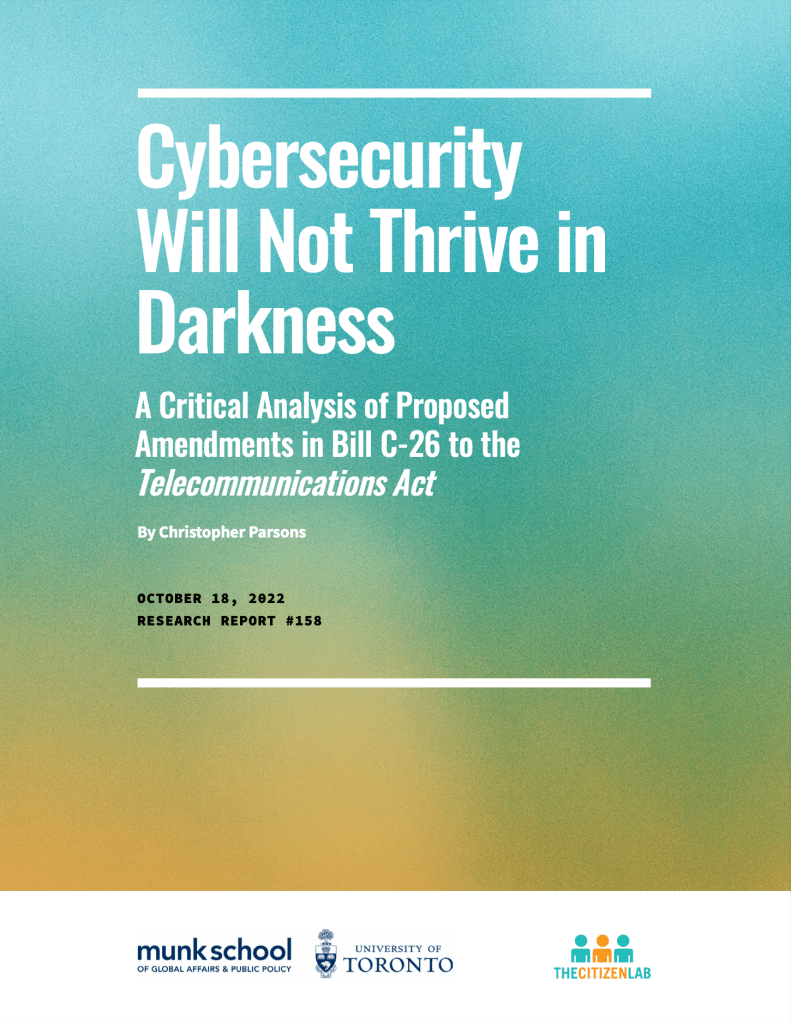
Last month I published a report, “Cybersecurity Will Not Thrive in Darkness: A Critical Analysis of Proposed Amendments in Bill C-26 to the Telecommunications Act.” The report undertakes a critical analysis of Bill C-26 which would empower the government to compel critical infrastructure companies to undertake (or refrain from taking) activities the government was of the opinion would enhance the security of Canada’ critical infrastructure. The report begins by offering a background to why this legislation is seen as necessary by the government and, then, proceeds to assess the elements of the legislation which would modify the Telecommunications Act. Specifically, it focuses on issues associated with:
- Compelling or directing modifications to organizations’ technical or business activities
- Secrecy and absence of transparency or accountability provisions
- Deficient judicial review processes
- Extensive information sharing within and beyond Canadian agencies
- Costs associated with security compliance
- Vague drafting language
30 different recommendations are offered that, if adopted, would leave the government able to compel telecommunications companies to modify their practices while, simultaneously, imbuing the legislation with additional nuance, restraint, and accountability provisions. As drafted, today, the legislation prioritises secrecy at the expense of democratic accountability and would establish law that empowered actions which were unpredictable to private organizations and residents of Canada alike. The effect would be to empower the government to undertake lawful, if democratically illegible, activities. Cybersecurity requires a high degree of transparency and dialogue to be successfully implemented. Security can be and must be aligned with Canada’s democratic principles. It is now up to the government to amend its legislation in accordance with them.
Executive Summary
On June 14, 2022, the Government of Canada introduced “Bill C-26: An Act respecting cyber security, amending the Telecommunications Act and making consequential amendments to other Acts.” If passed into law, it will significantly reform the Telecommunications Act as well as impose new requirements on federally regulated critical infrastructure providers. This report, “Cybersecurity Will Not Thrive in Darkness: A Critical Analysis of Proposed Amendments in Bill C-26 to the Telecommunications Act,” offers 30 recommendations to the draft legislation in an effort to correct its secrecy and accountability deficiencies, while suggesting amendments that would impose some restrictions on the range of powers that the government would be able to wield. These amendments must be seriously taken up because of the sweeping nature of the legislation.
As drafted at time of writing, Bill C-26 would empower the Minister of Industry to compel telecommunications providers to do or refrain from doing anything in the service of securing Canadian telecommunications networks against the threats of interference, manipulation, or disruption. The legislation would authorize the Minister to compel providers to disclose confidential information and then enable the Minister to circulate it widely within the federal government; this information could potentially include either identifiable or de-identified personal information. Moreover, the Minister could share non-confidential information internationally even when doing so could result in regulatory processes or private right of actions against an individual or organization. Should the Minister or other party to whom the Minister shares information unintentionally lose control of the information, there would be no liability attached to the government for the accident.
Where orders or regulations are issued, they would not need to be published in the Canadian Gazette and gags could be attached to the recipients of such orders. There may even be situations where the government could issue an order or regulation, with the aforementioned publication ban and gag, that runs counter to a decision by the Canadian Radio-television and Telecommunications Commission (CRTC) and that overrides aspects of that decision. And in any cases where a telecommunications provider seeks judicial review, it might never see the evidence used to justify an order or regulation. However, if a telecommunications provider is found to have deliberately ignored or failed to adhere to an order, then either the individuals who directed the action or the telecommunications provider could suffer administrative monetary penalties.
This report, in summary, identifies and analyzes a series of deficiencies in Bill C-26 as it is presently drafted:
- The breadth of what the government might order a telecommunications provider to do is not sufficiently bounded.
- The excessive secrecy and confidentiality provisions imposed on telecommunications providers threaten to establish a class of secret law and regulations.
- Significant potential exists for excessive information sharing within the federal government as well as with international partners.
- Costs associated with compliance with reforms may endanger the viability of smaller providers.
- Vague drafting language means that the full contours of the legislation cannot be assessed.
- No recognition of privacy or other Charter-protected rights exists as a counterbalance to proposed security requirements nor are appropriate accountability or transparency requirements imposed on the government.
- Even if it is presumed that the government does need the ability to encourage or compel telecommunications providers to modify their technical or business operations to enhance the security of their services and facilities, it is readily apparent that more transparency and accountability should be required of the government. All of the recommendations in this report are meant to address some of the existent problems in the legislation.
Should these recommendations or ones derived from them not be taken up, then the government will be creating legislation of the worst kind insofar as it will require the public—and telecommunications providers—to simply trust that the government knows what it is doing, is reaching the right decisions, and that no need exists for a broader public discussion concerning the kinds of protections that should be put in place to protect the cybersecurity of Canada’s telecommunications networks. Cybersecurity cannot thrive on secretive and shadowy government edicts. The government must amend its legislation to ensure its activities comport with Canada’s democratic values and the norms of transparency and accountability.




